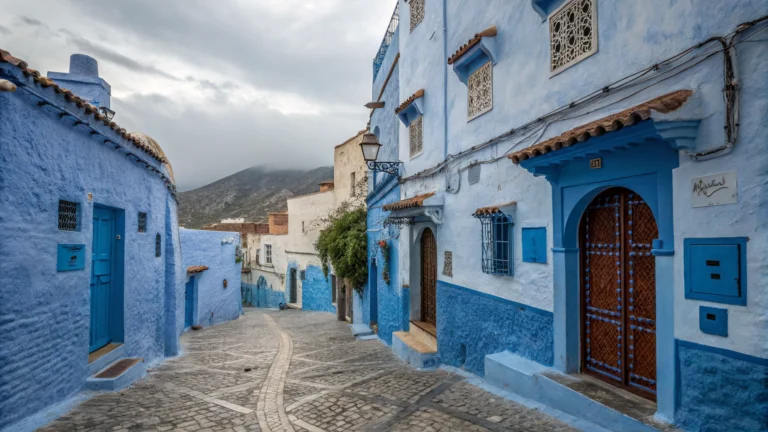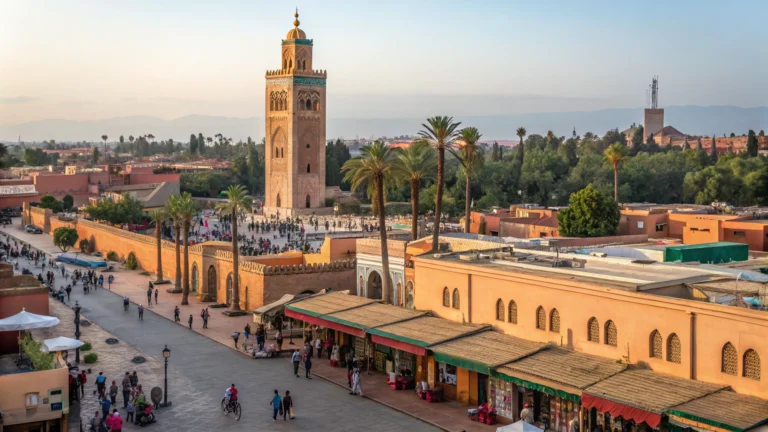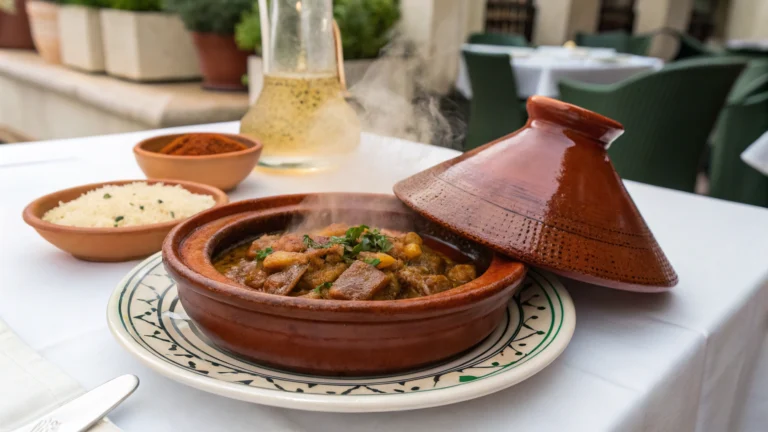Best Time to Visit Morocco: Complete Weather & Travel Guide
Did you know Morocco has four distinct climate zones in a country smaller than California? This North African gem has everything from snow-capped mountains to scorching desert dunes. These can be just hours apart by car.
Understanding Morocco’s weather is key to a great trip. The country’s geography leads to vastly different weather across regions. You’ll find cool Atlantic coastlines, alpine conditions in the Atlas Mountains, and extreme desert heat in the Sahara.
This guide shows you the optimal timing for your Moroccan adventure. You’ll learn about seasonal weather, temperature ranges, and rainfall. We’ll also cover cultural events, crowd levels, and budget tips for the best time to visit Morocco.
Table of Contents
Understanding Morocco’s Diverse Climate Zones
Morocco’s geography creates four climate zones that affect your travel. Each zone has its own weather, temperatures, and best times to visit. Knowing these morocco climate variations helps you pick the best places and pack right.
Coastal Atlantic Climate
The Atlantic coast of Morocco has temperate weather all year. Cities like Casablanca, Rabat, and Essaouira stay cool thanks to ocean breezes. This keeps temperatures nice even in summer.
Winter temperatures are 60-70°F (15-21°C), and summer is 70-80°F (21-27°C). The ocean keeps temperatures steady, avoiding extreme weather.
Rain falls mostly from November to March. The gentle climate makes coastal areas great for visiting any time. Summer is the best for swimming because of the warm ocean.
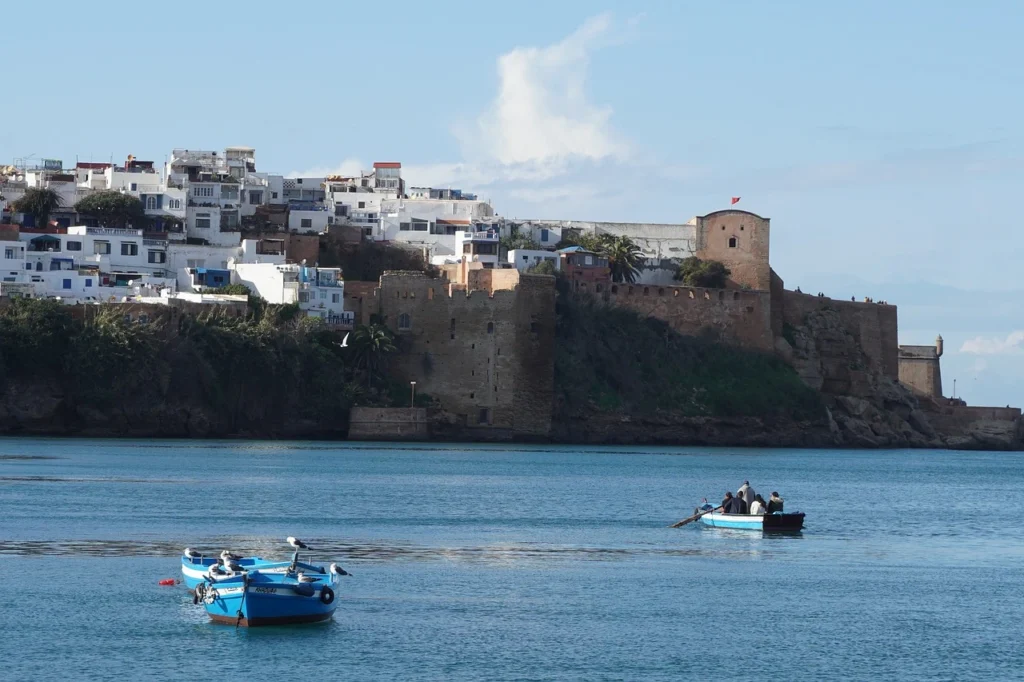
Mediterranean Climate in the North
Northern Morocco, including Tangier and Tetouan, has a Mediterranean climate. It’s warm and dry in summer, mild and wet in winter.
Summer temperatures are 75-85°F (24-29°C) with little rain. Winter is cooler, around 50-65°F (10-18°C), with some rain. This keeps the area green and lush.
The climate here is perfect for spring and fall. Summer is also pleasant, unlike inland areas.
Desert Climate in the South and East
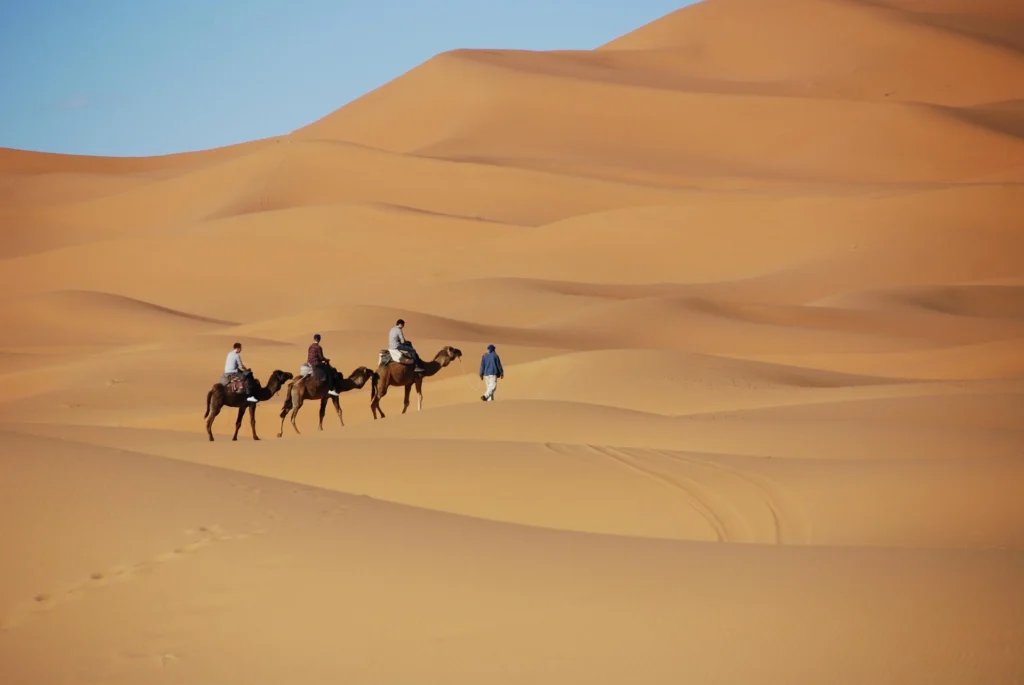
The desert areas, like Marrakech and the Sahara, have extreme temperatures. This climate is challenging for travelers.
Summer days can hit over 100°F (38°C). Winter days are 65-75°F (18-24°C). Nights drop sharply, to 40-50°F (4-10°C).
It rains very little, making it dry. The sun is strong, so you need shade and sun protection.
Mountain Climate in the Atlas Ranges
The Atlas Mountains have their own unique weather. They are cooler and can snow in winter. Each range has its own climate based on elevation.
Temperatures drop with altitude, making it cooler in summer. Snow falls above 6,000 feet (1,800m) from December to March. This is great for winter sports.
Summer is perfect for hiking with temperatures around 70-80°F (21-27°C). The mountains are best for trekking from April to October. July and August are popular, but watch out for thunderstorms.
Spring in Morocco: March to May
Spring turns Morocco into a paradise for travelers. The weather is just right, and the natural beauty is stunning. This makes spring the best time to explore.
Spring is perfect for seeing Morocco’s different landscapes. You can visit busy medinas and snow-capped mountains in comfortable weather.
This season offers unique chances you won’t find elsewhere. The mild weather, blooming flowers, and fewer people make spring great for first-timers.
Weather Conditions and Temperatures
Spring in Morocco is great for outdoor fun and sightseeing. Daytime temperatures are usually 68-77°F (20-25°C), perfect for walking.
Nights are cool but not cold. Expect lows around 50°F (10°C), ideal for rooftop dinners or evening walks.
Spring rain is light and rare. Northern areas might see some showers, but they clear quickly. This leaves the air fresh and clear for photos.
| Region | Daytime Temperature | Nighttime Temperature | Rainfall |
|---|---|---|---|
| Atlantic Coast | 70-75°F (21-24°C) | 52-57°F (11-14°C) | Light, occasional |
| Imperial Cities | 68-77°F (20-25°C) | 48-55°F (9-13°C) | Minimal |
| Atlas Mountains | 59-68°F (15-20°C) | 41-50°F (5-10°C) | Moderate |
| Desert Regions | 75-84°F (24-29°C) | 55-64°F (13-18°C) | Rare |
Best Activities and Destinations
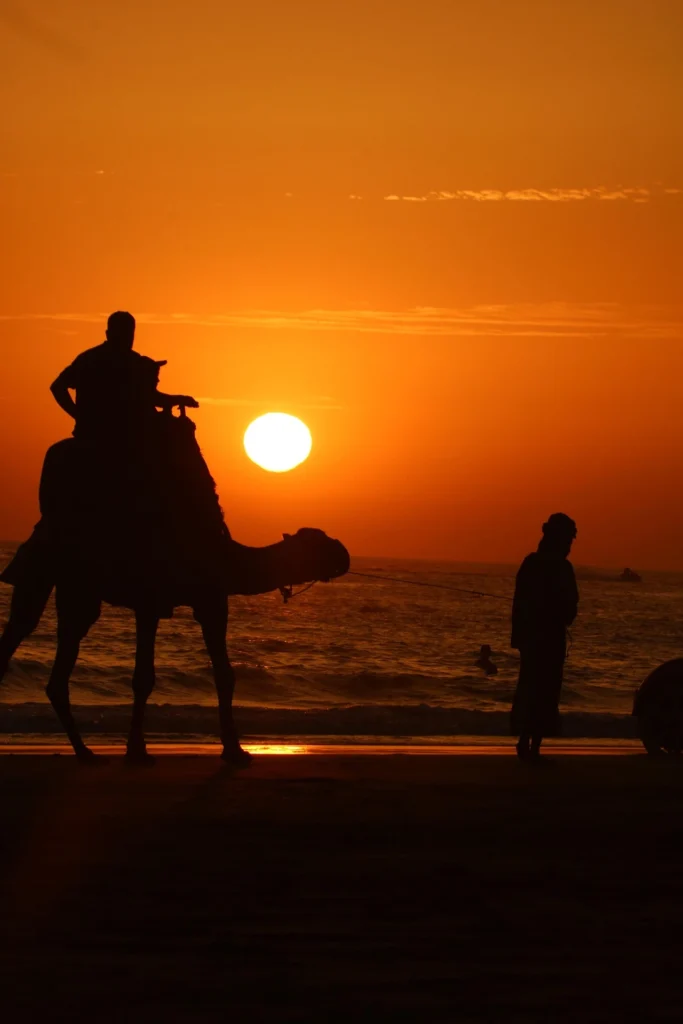
Spring is the best time for mountain adventures in the Atlas ranges. The wildflowers make hiking spectacular, with comfortable temperatures for long treks.
Imperial cities like Fez and Meknes are perfect in spring. You can explore without the summer heat.
Desert trips are at their best in spring. The Sahara offers comfortable camping conditions, with warm days and cool nights for stargazing.
Coastal areas have great beach weather without the summer heat. Enjoy swimming, surfing, and relaxation with pleasant temperatures and fewer people.
Photography lovers will find spring ideal. The clear skies and dramatic clouds make for stunning photos of Morocco’s landscapes.
Pros and Cons of Spring Travel
Spring travel in Morocco has many benefits. You’ll find moderate crowd levels, making it easier to interact with locals and visit popular spots.
Accommodation prices are reasonable in early spring. They increase as the season goes on, but you’ll find better deals than in winter.
The weather is versatile for all activities. Whether you like culture, outdoor adventures, or relaxation, spring temperatures are perfect.
But, spring travel has some downsides. Weather can be unpredictable, with cooler temperatures or rain in March.
More tourists come as spring goes on. While March is quiet, April and May get busier, with lots of visitors in Marrakech.
Packing for spring is tricky. You need clothes that can handle temperature changes, from day to night.
Booking early is key as spring progresses. Popular places and tours fill up fast, so book early for April and May.
Summer in Morocco: June to August
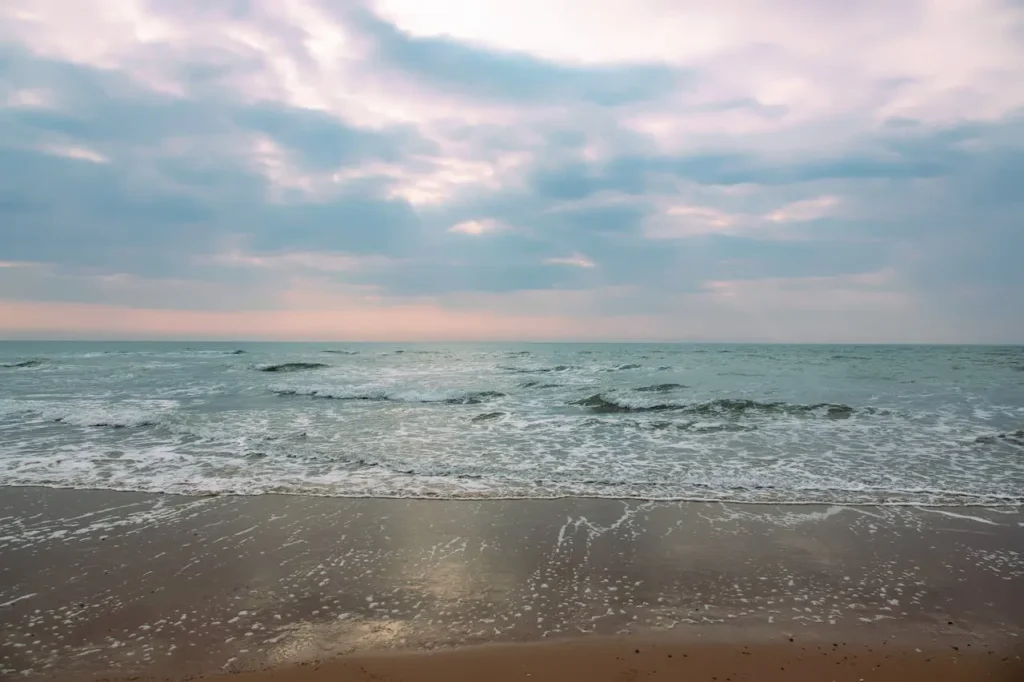
Morocco’s summer months from June to August offer different experiences. The morocco weather creates a tale of two countries. One is hit with extreme heat inland, while coastal areas offer cool breezes.
Summer brings both challenges and unique opportunities. Inland cities face intense heat, but coastal regions are perfect for beach lovers and water sports.
Heat and Weather Patterns
Summer turns Morocco into a land of temperature extremes. Cities like Marrakech and Fez see scorching daytime temperatures over 100°F (38°C). Sometimes, temperatures can hit 115°F (46°C) or more.
The weather patterns vary by region. Desert areas become almost uninhabitable, with temperatures up to 140°F (60°C). This makes desert tours hard for most visitors.
Despite the heat, inland areas have low humidity. This offers some relief. But, the high temperatures and bright sunshine make midday outdoor activities tough.
Coastal vs Inland Experiences
Coastal areas along the Atlantic Ocean have a different story. Cities like Casablanca, Rabat, and Essaouira enjoy comfortable temperatures from 75-85°F (24-29°C) during the day.
Ocean breezes cool the coast. These breezes make summer weather along the Atlantic pleasant for sightseeing and outdoor activities.
- Coastal advantages: Moderate temperatures, ocean activities, comfortable walking conditions
- Inland challenges: Extreme heat, limited midday activities, higher accommodation cooling costs
- Mountain regions: Cooler than deserts but warm, with pleasant evening temperatures
Managing the High Temperatures
Successful summer travel requires strategic planning and preparation. Adapt your schedule and expectations to the extreme conditions.
Timing is key in summer. Do outdoor activities early in the morning or late afternoon. Avoid the midday heat from 11 AM to 4 PM.
The secret to enjoying Morocco in summer is embracing the siesta culture. Rest during the hottest hours and enjoy the evening.
Essential summer strategies include:
- Accommodation: Book places with reliable air conditioning
- Hydration: Drink water constantly, even when not feeling thirsty
- Clothing: Choose lightweight, breathable fabrics with sun protection
- Itinerary: Focus on coastal cities or high-altitude mountain areas
Summer travel offers lower accommodation prices inland, fewer crowds, and more daylight for photography.
Fall in Morocco: September to November
Morocco’s autumn months are perfect for travel. The weather is ideal, harvests are vibrant, and culture is rich. This time makes the whole country a paradise to explore.
The summer heat fades, and the weather becomes pleasant. Desert adventures are enjoyable, and mountain regions are great for outdoor fun.
Ideal Weather Conditions
Fall brings Morocco’s most comfortable weather. Daytime temperatures are between 75-85°F (24-29°C) in most places. This is perfect for sightseeing and outdoor fun.
Evenings are cool but not cold. You’ll be comfortable in light clothes, making packing easier.
The stable weather allows for easy travel. You can move from coastal cities to desert camps to mountain villages without worries.
Harvest Season and Cultural Events
Fall is Morocco’s harvest time. You’ll see olive picking, date harvesting, and grape collection. It’s a chance for authentic cultural experiences.
Local communities invite visitors to join in harvest activities. These experiences offer a glimpse into Moroccan traditions and rural life.
Autumn is also filled with cultural events and festivals. You can enjoy local harvest celebrations and religious observances. It’s a time to experience Moroccan hospitality and traditions.
Why Fall is Considered Peak Season
Fall’s perfect weather and cultural richness make it the most popular time. Peak season morocco means you’ll see the country at its best.
But, this popularity has downsides. Prices for accommodations are high, and attractions are crowded. Riads in Marrakech and Fez book up early.
Restaurant reservations are key, too. The demand for quality places and experiences is high in October, when the weather is best.
Despite the challenges, fall is the best overall experience for new visitors and photography lovers. It offers the best weather and cultural experiences without weather worries.
Winter in Morocco: December to February
Winter in Morocco is surprisingly comfortable and often overlooked by travelers. From December to February, the country becomes a paradise with mild temperatures and fewer people around. It’s the ideal time morocco offers for those who love cooler weather and real cultural experiences.
Major cities have pleasant days with temperatures between 60-70°F (15-21°C) in winter. This makes walking and outdoor activities fun without the summer heat.
Mild Weather and Regional Variations
Morocco’s winter weather changes a lot from one region to another. Coastal cities like Casablanca and Rabat have mild weather thanks to ocean breezes. This keeps temperatures just right and humidity comfortable.
Northern areas get the most rain in winter, but it’s not a big deal. Rain falls in short bursts and sunny days are common. This means you can enjoy sightseeing and outdoor fun.
Central cities like Marrakech and Fez have the best winter weather. Days are perfect for exploring, but nights can get chilly. So, remember to wear warm clothes at night.
Mountain Snow and Desert Coolness
The Atlas Mountains get snow in winter, creating spectacular scenery. This is a unique chance for winter hiking and amazing photos.
Some mountain roads might be closed due to snow. Always check the weather and road conditions before heading out.
Desert areas are lovely in winter, with warm days and cool nights. The Sahara Desert is perfect for campfire gatherings and stargazing. But, desert nights can be cold, so dress warmly.
Winter Travel Advantages
Winter is great for budget travelers in Morocco. Prices for places to stay and eat are lower than in peak seasons. You’ll also find fewer people at popular spots.
Winter is the best time for cultural experiences and photography. With fewer tourists, you can really connect with locals and enjoy the culture.
Winter is perfect for older travelers or those who can’t handle the heat. The weather is comfortable, and you can explore without worrying about heat exhaustion. Just remember to bring layers for the occasional rain in the north.
Best Time to Visit Morocco by Region
Every part of Morocco has its own best time to visit. Knowing the weather in each area helps you enjoy your morocco travel more. Some places are better to visit in certain months, making when you go as important as where you go.
Marrakech and Central Morocco
Marrakech is best from October through April. The weather is nice, with temperatures between 70-80°F (21-27°C). This is perfect for exploring the medina, visiting Majorelle Garden, and enjoying meals on rooftops.
Summer is very hot, over 100°F (38°C). But, mornings and evenings are nice if you plan your day right.
Casablanca and Atlantic Coast
The Atlantic coast has year-round moderate temperatures thanks to the sea. The best time is from May through October. This is great for beach activities, surfing, and walks by the sea.
Winter is mild, with temperatures rarely below 50°F (10°C). It’s perfect for sightseeing and exploring culture.
Fez and Northern Cities
Northern Morocco is best from April through June and September through November. The weather is nice for visiting Fez’s medina and nearby sights without the summer heat.
Winter can be rainy and cool. Summer can be very hot, making the medina streets warm during the day.
Sahara Desert Regions
The desert is best from November through March. The weather is nice for camping and camel rides. Nights can be cool.
Summer is too hot, over 120°F (49°C). It’s not safe for outdoor activities.
“The key to successful Morocco travel lies in matching your destinations with their optimal seasons.”
| Region | Best Months | Peak Temperature | Main Advantages |
|---|---|---|---|
| Marrakech/Central | October-April | 70-80°F (21-27°C) | Comfortable sightseeing, pleasant evenings |
| Atlantic Coast | May-October | 65-75°F (18-24°C) | Beach activities, ocean breezes |
| Northern Cities | April-June, Sep-Nov | 75-85°F (24-29°C) | Ideal medina exploration |
| Sahara Desert | November-March | 70-85°F (21-29°C) | Desert camping, camel trekking |
Consider visiting in late March or early November for good weather and lower prices. This way, you can see Morocco’s beauty without the heat or crowds.
Peak Season vs Off-Season Travel
Morocco’s tourism seasons offer different experiences. Your choice between peak and off-season affects costs and crowds. Knowing these patterns helps you plan your trip better.
Understanding Tourist Seasons
The peak season in Morocco is from October to April. The best time is from November to March, with nice weather everywhere. Spring and fall are good too, with fewer people.
Off-season morocco travel is from June to September. It’s hot inland, but coastal areas are okay. This time is cheaper and less crowded.
Crowd Levels and Booking Considerations
Peak season means big crowds in places like Marrakech’s Jemaa el-Fnaa square. Attractions are busier, and restaurants need bookings. It’s hard to take photos with so many people.
Booking in peak season is tough. You need to book 3-6 months early for nice places. Off-season, you can book last minute and find great deals.
Off-season, attractions are almost empty, and restaurants have seats right away. Hiking and cultural sites are peaceful.
Pricing Differences Throughout the Year
Accommodation prices change with the seasons. Luxury places cost 50-100% more in peak months. Off-season, you can save a lot.
| Season | Accommodation Cost | Tour Prices | Crowd Level | Weather Quality |
|---|---|---|---|---|
| Peak (Nov-Mar) | Highest (+50-100%) | Premium rates | Very busy | Excellent |
| Shoulder (Apr-May, Sep-Oct) | Moderate (+20-40%) | Standard rates | Manageable | Good |
| Off-Season (Jun-Aug) | Lowest (-40-60%) | Discounted | Minimal | Challenging |
Tour prices change with the seasons too. Desert trips and mountain hikes are cheaper in summer but less comfortable. Transportation costs stay the same, but flights are pricier in winter and spring.
Think about what you want before choosing when to travel. If you’re on a budget and don’t mind the heat, off-season is best. For the best weather and experiences, peak season is worth the extra cost.
Morocco’s Festival Calendar and Cultural Events
Morocco’s festival calendar turns regular trips into unforgettable cultural adventures. The country’s mix of religious and cultural events offers unique chances all year. But, planning your visit around these events is key to make the most of your trip.
Knowing when these celebrations happen helps you choose the best travel dates. You can dive into the festive vibe or pick quieter times for a more relaxed trip.
Major Religious Holidays
Religious holidays in Morocco follow the Islamic lunar calendar, which changes about 11 days each year. Ramadan is the biggest factor for travelers planning their Morocco trip.
During Ramadan, the country changes a lot. Many restaurants are closed during the day, and tourist spots have shorter hours. It’s important to respect fasting by eating and drinking quietly in public.
But, the evening iftar celebrations are magical. Streets come alive after sunset with families sharing meals and enjoying late-night fun.
Eid al-Fitr and Eid al-Adha bring joyous celebrations lasting several days. These events offer great cultural experiences, but many businesses close, affecting travel and plans.
Cultural Festivals by Season
Each season in Morocco has its own cultural celebrations. Spring is famous for the Rose Festival in Kelaat M’Gouna in May. The valleys are filled with pink roses and traditional rose water ceremonies.
Summer brings the Gnawa World Music Festival in Essaouira in June. This festival is a global event, attracting musicians and visitors from everywhere.
Fall is home to the Marrakech International Film Festival in November. It turns the red city into a glamorous cultural center. Winter celebrates regional festivals, including spectacular almond blossom festivals in the Atlas Mountains.
These events give you a chance to see traditional music, dance, crafts, and local customs. You’ll learn about Morocco’s culture in a way you can’t with regular tourist activities.
Planning Around Local Celebrations
Festival timing greatly affects your travel experience and budget. Popular events make accommodation prices soar in host cities.
If you want to truly experience Morocco’s culture, look up festival dates early. Book your stay months in advance. Expect higher prices and more people during big celebrations.
Or, if you prefer a quieter trip, avoid peak times. Look up religious holiday and festival dates when planning your trip.
Think about what you like. Festival periods offer deep cultural immersion but need flexibility and patience. Quiet times are easier and cheaper but offer fewer cultural chances.
Activity-Based Timing for Your Morocco Trip
Planning your Morocco trip around activities makes it unforgettable. Each area has special things to do at different times. Choose the best time to visit Morocco based on what you love to do.
Knowing when the seasons change helps plan your trip. This way, you can enjoy Morocco’s best moments without bad weather.
Desert Adventures and Sahara Expeditions
Desert trips need the right timing for safety and comfort. The best time to visit Morocco for Sahara trips is from November to March. The days are cool, and nights are great for camping.
December and January are the best for desert fun. The weather is perfect for camel rides and long outdoor adventures. These months are great for watching sunrises and going on multi-day trips.
Summer is too hot for desert trips. Temperatures can be deadly, making it hard to be outside. Stay away from June to August for desert adventures.
Mountain Adventures in the Atlas Ranges
Mountain trips have two best times in Morocco. April to June is perfect for wildflowers and nice weather. The skies are clear, and it’s comfortable for long hikes.
September to November is another great time for mountains. The weather is stable, and views are clear. Fall is the best time for serious hikes.
Winter offers a chance for snow treks for the brave. But, you need the right gear and planning.
Coastal and Beach Experiences
The Atlantic coast is great all year, but May to October is best. The water is warm for swimming and sports. It’s perfect for beach fun.
The coast is nice for walks and sightseeing any time. Even in winter, it’s good for beach walks. The Atlantic coast has consistent weather for visitors.
Summer is the best for beach vacations. The water is warm, and it rains less. It’s the best time to visit Morocco for beach lovers.
Urban Exploration and Cultural Immersion
Exploring cities is best from October to April. Walking in old medinas is easier, and museums and outdoor dining are more enjoyable.
Spring and fall are great for photos. The light is perfect, and skies are clear. Cultural tours are more comfortable when it’s not too hot.
Summer city trips need careful planning. It’s hard to walk in cities like Marrakech and Fez because of the heat.
Travelers who want to do it all should go in shoulder seasons. April to May and September to October are good. These periods are the best time to visit Morocco for a full experience.
Photographers love fall and winter for the light. Spring has beautiful colors and landscapes for amazing photos.
Packing Essentials for Each Season
Your packing strategy is key to enjoying Morocco’s weather changes. It’s important to know how morocco weather changes in different places and seasons. Pack versatile items that can handle different weather conditions.
Morocco has many climates, from hot deserts to cool mountains and mild coasts. The right gear helps you move smoothly between these climates.
Spring and Fall Packing Lists
Spring and fall are the best times to visit Morocco. But, you need to pack layers for the temperature changes. Mornings are cool, afternoons warm, and evenings get chilly again.
Start with lightweight base layers like cotton t-shirts and tank tops. Add medium-weight cardigans or light jackets for cooler evenings. A waterproof jacket is good for spring rain in the north.
Footwear is key in these seasons. Comfortable walking shoes are great for cobblestone streets. Bring sandals for warm afternoons and closed-toe shoes for mosques.
Summer Survival Gear
Summer in Morocco is very hot, so you need to stay cool. The right cooling accessories and protective gear are essential.
Wear loose, light-colored clothes to reflect the sun’s heat. Cotton and linen are better than synthetic fabrics. Wide-brimmed hats protect your face and neck from the sun.
Staying hydrated is a must. Use insulated water bottles to keep drinks cool. Electrolyte supplements are good for desert trips where you’ll sweat a lot.
Cooling accessories help make hot situations more comfortable. Use cool neck scarves and portable battery fans for extra cooling.
Winter Clothing Considerations
Winter in Morocco is colder than you might think. Desert nights and mountain areas can be very cold. You’ll need warm layers that most visitors don’t expect.
Bring warm sweaters and fleece jackets for cooler areas. Waterproof jackets are good for northern Morocco’s winter rain. Choose versatile pieces that work for both cool mornings and warm afternoons.
Remember to dress modestly all year. Pack clothes that cover your shoulders and wear long pants for mosques. A lightweight scarf is useful for warmth and cultural respect.
| Season | Essential Items | Temperature Range | Special Considerations |
|---|---|---|---|
| Spring/Fall | Layering pieces, waterproof jacket, walking shoes | 50-80°F | Variable weather, occasional rain |
| Summer | Light clothing, sun hat, cooling gear | 70-110°F | Extreme heat, intense sun exposure |
| Winter | Warm layers, waterproof outer wear | 40-70°F | Cold nights, mountain snow possible |
| Year-round | Modest clothing, comfortable shoes, first aid | Variable | Cultural respect, diverse terrain |
Use packing cubes to organize your clothes by season. This makes it easy to find the right clothes for different weather and cultural needs.
Planning Your Morocco Trip Timeline
Planning your trip to Morocco means knowing when to book and how to save. It’s all about finding the right balance between early reservations and seasonal timing. This way, you can enjoy the best experiences while keeping costs down.
Morocco’s diverse regions and changing seasons make planning tricky. Peak season, from October to April, needs more planning than the summer. Summer is easier, with more places available even with shorter booking times.
Booking Windows for Different Seasons
For peak season travel in Morocco, book 3-6 months in advance for top spots. Places like Marrakech and Fez’s luxury riads get booked up to 6 months early for the best times.
Off-season travel gives you more freedom. You can book summer trips 4-8 weeks in advance. This way, you can keep an eye on the weather and change plans if needed.
Shoulder seasons, like late spring and early fall, are ideal for booking. Book 8-12 weeks ahead for good deals without the rush of peak season.
Building Your Seasonal Itinerary
Begin by picking your must-see spots and then plan your trip back. Make sure to choose places with good weather during the off-season.
Coastal areas are best in summer to avoid the heat. In winter, head to the desert for camel rides and camping. This way, you enjoy the weather.
Plan indoor and outdoor activities based on the season. Summer days are best for early and late outings. Winter is perfect for full-day adventures outside.
Stay longer in places with good weather. Quality experiences are more important than rushing through many places.
Strategic Planning Approaches
Planning early gets you the best deals and ensures you can do what you want. Look for early-booking discounts to save money.
Last-minute planning is good for off-season trips. Prices drop, but you need to be flexible with your plans.
Combining early and last-minute planning is often the best strategy. Book the essentials early and leave room for spontaneity.
Keep an eye on prices and set up alerts for your favorite places. Many websites offer price tracking to help you save.
Travel insurance is key for early planners. It protects your investment against unexpected changes or global issues.
Book refundable rates when you can. This flexibility lets you change plans if better deals come up or if your plans change.
Conclusion
Your perfect Morocco travel experience depends on balancing personal preferences with seasonal advantages. Spring and fall offer the most comfortable weather across all regions. They are ideal for first-time visitors exploring diverse destinations from Marrakech’s bustling medina to the Sahara Desert’s golden dunes.
Each season brings unique benefits to your Morocco travel plans. Winter delivers budget-friendly rates and pleasant desert conditions. Summer provides uncrowded coastal experiences in places like Essaouira. Peak seasons offer optimal weather but come with higher costs and larger crowds visiting popular sites in Fez and Casablanca.
Morocco’s geographic diversity means you can find pleasant conditions somewhere in the country year-round. The Atlas Mountains offer cool retreats during hot summers, while coastal areas provide relief from inland heat. Desert regions shine during cooler months when temperatures become comfortable for camel trekking and overnight camping.
Successful Morocco travel requires flexibility and realistic expectations about weather variations. Your interests should guide timing decisions – whether you prioritize cultural festivals, outdoor adventures, or budget considerations. Start planning your Morocco travel adventure today using these seasonal insights to choose dates that match your vision of the perfect Moroccan experience.


